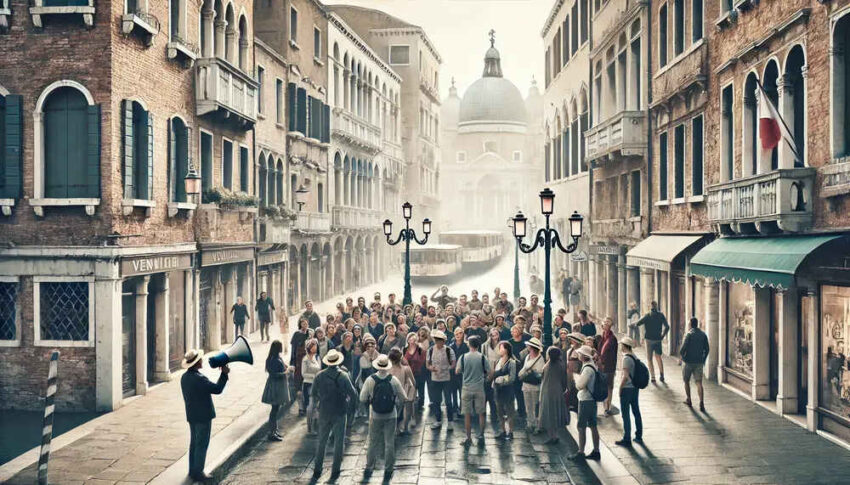Reading Time: 3 minutes
As part of its efforts to manage large crowds and enhance the quality of life for its residents, the iconic Italian city has implemented restrictions on tour group sizes.
Venice has implemented a new regulation prohibiting the use of megaphones by tour guides and restricting tour groups to a maximum of 25 people. These measures, effective from Thursday, are part of the city’s efforts to manage tourism better and protect its historical ambiance.
While the new rules are strict, certain exemptions are in place. Children under the age of two, school groups, and educational trips are not subject to the group size limit. This policy is also extended to include tours on the nearby Venetian islands of Murano, Burano, and Torcello, ensuring a consistent approach across the region.
The implementation of these restrictions was initially scheduled for June. However, the introduction was postponed due to the fact that many guides had already scheduled tours that exceeded the new 25-person limit, highlighting the challenges of adjusting to these new requirements.
Tour guides who do not comply with these regulations risk facing penalties. Fines for violations can range from €25 to €500, depending on the severity of the breach, underscoring the city’s commitment to enforcing the new rules.
These changes reflect Venice’s ongoing efforts to balance the needs of its tourism industry with the preservation of its cultural heritage and the quality of life for its residents. By limiting group sizes and reducing noise pollution from megaphones, the city aims to create a more sustainable and enjoyable environment for both visitors and locals.
Venice has outlawed the use of loudspeakers by tour guides, citing that these devices often cause confusion and disturbances. This move aims to reduce noise pollution and enhance the overall experience for both tourists and residents.
This new rule is part of a broader initiative to manage tourism more effectively and maintain the city’s tranquil atmosphere. By eliminating loudspeakers, Venice seeks to ensure a more peaceful and enjoyable environment for everyone exploring its historic sites.
Elisabetta Pesce, the city official responsible for security, stated last year that these policies aim to enhance the flow of tour groups through Venice’s historic center and the frequently visited islands of Murano, Burano, and Torcello.
Additionally, the measures are designed to improve the quality of life for the city’s residents and workers, ensuring that the bustling tourism industry does not impede daily activities.
Venice is employing several strategies to manage the influx of tourists. Among these measures is the introduction of a new fee for day-trippers. This €5 per person charge was applied on 29 peak days from April to mid-July, covering most weekends during this period.
The purpose of this fee is to help control crowd sizes, promote longer stays, and ultimately enhance the quality of life for the residents of Venice. By encouraging visitors to spend more time in the city, officials hope to alleviate the pressure of short-term tourism on the local infrastructure and community.
During the trial, the city collected a total of €2.2 million from approximately 450,000 visitors. While the initiative was designed to balance tourism benefits with residents’ well-being, it has faced criticism from some quarters, who have labeled it a “failure.”
Despite the mixed reviews, Venice continues to explore various methods to manage tourism effectively. The city remains committed to finding sustainable solutions that ensure both tourists and locals can coexist harmoniously in this unique and historic destination.
The UN cultural agency has twice considered listing Venice as a heritage site in danger, citing the significant impact of tourism on the city’s delicate lagoon environment as a major factor.
Venice initially avoided being placed on UNESCO’s endangered heritage list by implementing restrictions on the arrival of large cruise ships via the Giudecca Canal. This decisive action was aimed at protecting the fragile ecosystem and preserving the city’s unique architectural heritage from the adverse effects of massive ship traffic.
The city faced the threat again last September but managed to evade the designation by announcing the introduction of a day-tripper fee. This measure, designed to regulate tourist numbers and mitigate overcrowding, had been postponed due to the significant drop in tourism during the COVID-19 pandemic. The fee aimed to strike a balance between welcoming visitors and maintaining the quality of life for residents.
Despite these efforts, the challenges of managing tourism in Venice persist. The city continues to explore and implement strategies to protect its cultural and natural heritage while accommodating the millions of tourists who flock to its historic sites each year. By taking proactive steps, Venice hopes to ensure its long-term sustainability as a cherished global destination.
The post New Tourism Rules In Venice: Groups Limited To 25, Megaphones Prohibited appeared first on Travel And Tour World.

